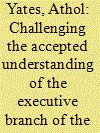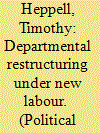| Srl | Item |
| 1 |
ID:
177689


|
|
|
|
|
| Summary/Abstract |
The accepted understanding of what constitutes executive government in the United Arab Emirates (UAE) is that power rests with the Cabinet. This is, however, only partially correct. In reality, executive power over national security is excised from the Cabinet, and instead rests with a group of legislatively-defined agencies and posts. In other words, institutionally the UAE’s executive branch is bifurcated, with one part handling ‘high’ policy, meaning national security, and the other ‘low’ policy, that is all the rest. This article describes the unobserved part of the UAE’s executive branch. In doing so, it provides a significant advance in the understanding of the somewhat opaque nature of government in the UAE. Importantly, it provides a more nuanced understanding of the sources of power as they relate to the powerful Sheikh Mohammed bin Zayed Al Nahyan, a person often (mis)characterised as the de facto leader of the UAE.
|
|
|
|
|
|
|
|
|
|
|
|
|
|
|
|
| 2 |
ID:
107208


|
|
|
|
|
| Publication |
2011.
|
| Summary/Abstract |
Despite their emphasis on joined up government, which was to be one of the defining features of the New Labour governing project, attempts to enhance policy delivery would also result in major departmental restructuring within each of their three terms in office. This article asks three questions with regard to the New Labour and departmental restructuring. First, from a historical comparative perspective was there a greater degree of departmental restructuring under New Labour than under previous governments? Second, in the case of New Labour what was the motivation for departmental restructuring? Finally, was New Labour characterised by successful departmental restructurings? Utilising select committee material for the views of civil servants and combining this with questionnaire feedback from former New Labour ministers this article seeks to address these questions to assess the record of departmental restructuring in the New Labour era.
|
|
|
|
|
|
|
|
|
|
|
|
|
|
|
|